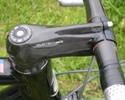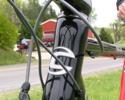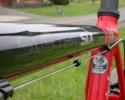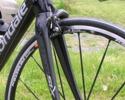
Recently on Cyclingnews.com |
Tech feature: Cannondale System Six product launch, May 22, 2006Born in Bedford; meant for the pelotonOver the first weekend in May, Cannondale officially released its newest road bike, the System Six, during a global media junket and test ride at its factory in Bethel, PA. Cyclingnews’s Steve Medcroft was on hand to get dropped by the group.
Cannondale’s launch of the System Six wasn’t the first time the new frame has been seen this year; prototypes appeared at the Tour of Georgia. At that race, Mike Sayers and Gord Fraser of the Cannondale-sponsored Health Net Pro Cycling Team are reported to have insisted the bike immediately replace their current racing machines after just one ride each. In the latter half of the Spring Classics Barloworld rider Igor Astarloa was also spotted on a System Six. Manufactured completely in Cannondale’s Bedford factory, the new bike has a distinctively Cannondale look; oversized down tube, a chunky head tube and a slightly-sloping, wide and oval top tube. The new tubing configurations are a by-product of two initiatives in the company — a reinvigoration of research and development money now that the company has emerged from bankruptcy protection and an upgrade of its carbon processing capabilities to a level on par with aerospace manufacturing standards. Carbon fever Although Cannondale has worked with carbon fiber in its frame building since the Raven mountain bike in 1992, the System Six represents a significant investment in carbon processing. Improvements include a staging freezer for the spools of raw carbon fiber — the material degrades if it’s not stored properly. “The CNC fabric cutter room is also brand new,” said composite design engineer Brad Paquin. “We also invested in some very expensive tooling and doubled our hot press capacity to build this bike.” The new capabilities allow Cannondale to engineer some very specific performance characteristics into the tubing of the System Six. “The [48mm wide and 38mm tall oval] top tube design is optimized for maximum lateral rigidity while minimising the increase in vertical stiffness,” said Paquin. “The down tube is designed for maximum torsional rigidity at the bottom bracket (which is why it’s a very oversized 56mm the BB shell). The down tube transitions to a teardrop shape at the head tube to provide a higher degree of impact resistance — without adding weight.” The head tube owes its own unique chubbiness to two reasons. “First is so that the down tubes and top tubes could be attached to it without necking down,” said Paquin. “You can imagine what the bike would look like with radically oversized top tube and down tube but a standard 1 1/8in head tube.” The oversized head tube also adds torsional stiffness to the front end of the bike. The tubing is prepared to spec in the carbon cutting room from rolls of unidirectional high-modulus fiber, which creates an odd-looking finish for anyone who’s seen the crosshatch of a lot of modern carbon fiber bike frames. “Typically, what you’re seeing on most carbon parts is a woven carbon fiber cosmetic layer,” said Paquin. “This is done to conceal any ‘ugly’ areas in the laminate beneath the top sheet.” But Cannondale’s use of unidirectional carbon fiber (which simply means that the fibers are not woven together – all the fibers run in the same direction) means that the final tubing can be formed to almost to its final shape, eliminating the need for a cosmetic cover up. High modulus refers to the grade of fibers; the modulus of elasticity (the force it takes to deform the fibers, measured in pounds per square inch). Paquin that Cannondale was using the highest grade of carbon fiber available for bicycle frame use. There is an ultrahigh modulus carbon fiber on the market but, “ultra high modulus fibers are to brittle for use in sporting goods,” he said. Once formed, the Cannondale’s new tubes progress to the lay-up room. “The tubes are installed in a lay-up fixture which holds the preforms at the proper angles,” Paquin says. “Fibers are then placed where they need to be (our proprietary process that we don’t want to be released to the public) and the form is removed from the lay-up tool as one piece.” For the rear of the bike, Cannondale sticks to its belief that its CAAD aluminum rear end is its best way to complete the System Six. “The typical ways other companies make full carbon rear ends results in too many bond joints,” Paquin said. “More bond joints mean more places to form cracks, and more material overlap." That means increased weight,according to Paquin. Did this fresh approach to design pay off in the final product? Cannondale thinks that its comprehensive testing proves that it does. “Once we manufacture a solid prototype,” said design engineer Chris Peck, “we submit it to 14 stiffness tests and our full barrage of ESAL [Experimental Stress Analysis Laboratory; Cannondale’s trade name for its testing facility] fatigue and destructive testing.” By testing the new frame alongside team-issue carbon frames from other manufacturers, Cannondale believes it has achieved a frame that is laterally and torsionally stiffer than anything currently on the market. And Cannondale has the charts to prove it. The company’s test lab data indicates that the new System Six down tube is 44 percent torsionally stiffer than the Six13 down tube. The top tube tests 304 percent laterally stiffer. The head tube is 36.8 percent stiffer. All this in a frame that weighs only 1,115 grams (with the derailleur hanger, bottle and cable mounts and headset and bottom bracket inserts in place). The ride We only were able to spend five short hours riding the System Six (stay tuned to Cyclingnews in the future as we hope to put the bike through a much more rigorous round of test riding). After lengthy testimony and scientific propaganda about how high-performance of a machine this was, I expected a technically sound ride that only an elite-level pro with a sprint output over a thousand watts would appreciate. Cannondale ride leaders (super-thin, weather-tanned chaps with thousands of miles under their legs who could probably ride straight up the sides of buildings if they wanted) spun us over seventy miles of rolling Pennsylvania hill country. We rode in and of valleys over an endless series of short, steep hills. It was an in-the-saddle to out-of-the-saddle, granny-gear straight to big-ring kind of riding. Just as I expected, the System Six had tight handling, reacted finely to steering input, and was rigid on twisty descents. But I was surprised by how comfortable this bike was. It’s normally hard to adjust to the feel and fit of a new machine but for all of the hours I rode, I rode in perfect comfort; smiling and watching the scenery go by as I was kicked off the back of the group . Cannondale finishes off the System Six with a custom carbon stem (available from 80 to 130mm), and a Hollowgram System Integrated carbon crankset (which comes SRM-equipped as an option). It’s scheduled to ship to retailers in July of 2006. At the media camp, Cannondale showed us four different builds: SRAM Force; Shimano Dura-Ace; and Shimano Ultegra models for most of the seventy countries where Cannondale bikes are sold; and a full Campagnolo Record version for Europe. No retail pricing was yet available. Our strong first impression is that Cannondale has packaged together a bicycle that can both keep a racer fresh after six long hours in the saddle and give him the superior stiffness he needs in the sprint. The System Six is the kind of bike any elite-level cyclist is going to want to own. Photography
For a thumbnail gallery of these images, click here Images by Steve Medcroft/Cyclingnews.com
|









